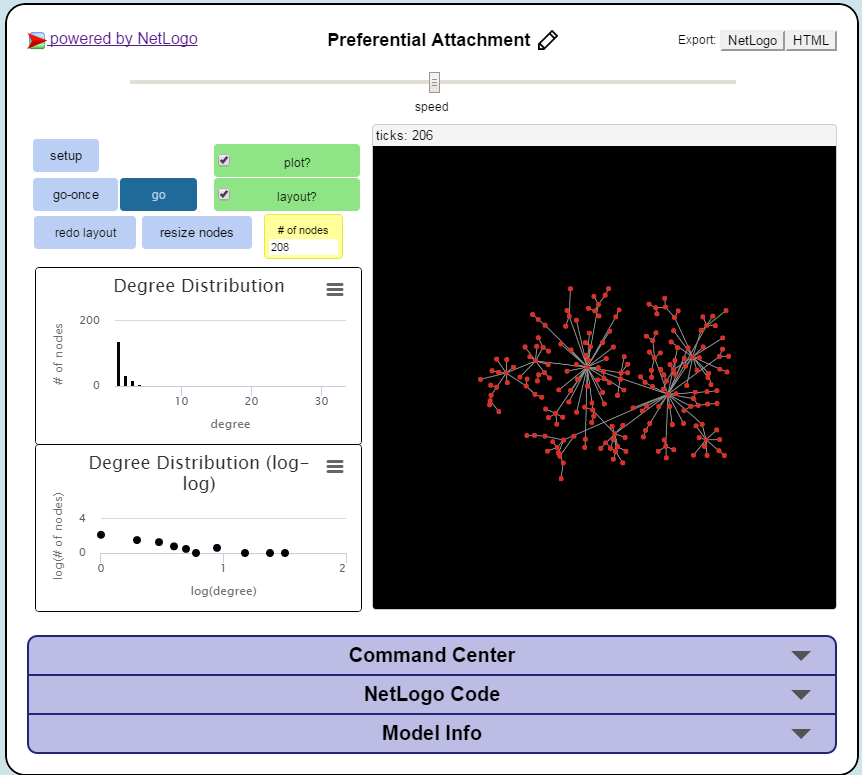
Several books have been published about NetLogo. In addition to agent-based modeling, NetLogo also includes basic support for dynamic system modeling. NetLogo was designed and authored by Uri Wilensky, director of Northwestern University's Center for Connected Learning and Computer-Based Modeling (CCL). Many teachers make use of NetLogo in their curricula. It is in use in a wide variety of educational contexts from elementary school to graduate school. NetLogo is open source and freely available from the NetLogo website. Beyond exploring, NetLogo allows authoring new models and modifying extant models. NetLogo allows exploration by modifying switches, sliders, choosers, inputs, and other interface elements. It comes with an extensive models library including models in a variety of domains, such as economics, biology, physics, chemistry, psychology, system dynamics. The NetLogo environment enables exploration of emergent phenomena. Many scientific articles have been published using NetLogo. NetLogo was designed with multiple audiences in mind, in particular: teaching children in the education community, and for domain experts without a programming background to model related phenomena. It teaches programming concepts using agents in the form of turtles, patches, links and the observer. NetLogo was designed by Uri Wilensky, in the spirit of the programming language Logo, to be "low threshold and no ceiling". NetLogo is a programming language and integrated development environment (IDE) for agent-based modeling.

Also worth looking at is the RNetLogo package for running NetLogo inside R./ 30 September 2022 6 months ago ( 30 September 2022) The complete NetLogo file can be found at found at Modeling Commons. The implementation of bacterial chemotaxis is straightforward, using the previously defined reporter calculate-slope: to go single simulation step for both demos Set pcolor (30 + (9.9 * (value - min-value) / (max-value - min-value)))
#Netlogo of code
Returning to our example, most of the setup code calculates a chemical gradient, but some bacteria are also created: code for SETUP button - Bacteria Related uses of R for agent decision-making include implementations of neural networks, clustering, pattern-recognition, and the like. R:eval "valu.lm <- lm(valu.hist ~ valu.index)"Ī slightly more efficient option would have been to use r:eval to define an R function in setup, and then to call it here with valu.hist as an argument.

R:eval "valu.index <- 1:length(valu.hist)" The r:get reporter is used to return the value of an R expression (in this case, the slope): to-report calculate-slope R interface - calculate slope for values in lst r:put "valu.hist" lst We make the decision using the reporter below, which calculates the slope of the best-fit line through the datapoints (this is a very simple example of using R code to implement an agent’s decision-making). Bacteria move up a chemical gradient by moving in a straight line if the concentration is increasing, and by randomly changing direction if it is not. The second demo (see screenshot above) simulates bacterial chemotaxis. Set history (lput (total / cell-count) history) Record current density

Ifelse (counter = 3 or (counter = 2 and alive?)) The step code is also straightforward, using two phases (one to count live neighbours, and one to compute the future state): to go single simulation step for both demosĪsk patches ) ]
#Netlogo of Patch
To birth this procedure applies to a specific patch To death this procedure applies to a specific patch Ifelse (random-float 1 < average-life-density) The setup code for the “Game of Life” is fairly straightforward, using two utility functions to make a patch alive or dead: code for SETUP button - Life Window number of steps over which to analyseĬounter used to pass number of live neighbours between Phase 1 and Phase 2 for BACTERIA Is-life? distinguish between the two demos for LIFE The implementation combines variables for both examples in this tutorial: globals [ More sophisticated statistical analysis in R includes the use of spatial techniques.


 0 kommentar(er)
0 kommentar(er)
